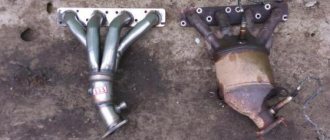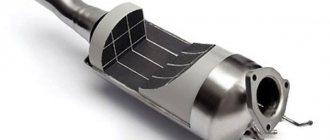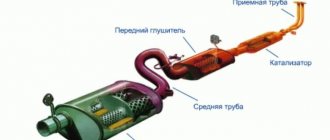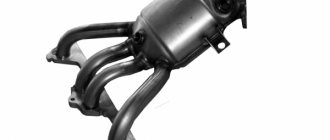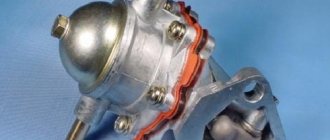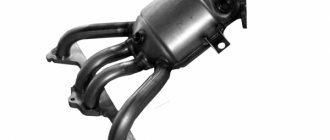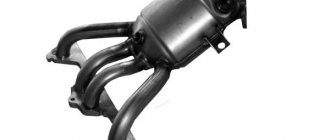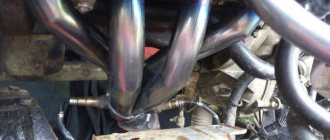Catalyst structure
From the outside, the catalytic converter mechanism looks like an ordinary piece that is included in the exhaust system. The housing contains an element that provides catalysis. It is covered with an outer coating - a special layer of various metals. Mostly from the platinum category. This device has a clear cylindrical shape and a honeycomb-like structure.
The honeycombs are located close to each other, and due to the fact that there are many of them, good contact is ensured between the exhaust gases and the coating. This allows the exhaust to oxidize much better.
Due to the small diameter of the honeycombs, they become dirty very quickly. This is facilitated by a huge amount of bad oil and low-quality gasoline. Since the exhaust gases are not cleaned by the vehicle's proper system, it becomes harder for the vehicle to operate. That is why it is necessary to control this issue and stop all attempts at breakdowns. Engine performance deteriorates significantly due to malfunctions, and some negative consequences appear. The chamber ceases to be properly purged, and the engine begins to lack fuel for full operation. Consequently, consumption increases. There is also an alternative option - the honeycombs simply melt. However, the outcome still remains the same - consumption still increases.
Catalytic Converter Repair
Removing the neutralizer looks like this: ceramic parts are removed from the catalyst, and then the empty block is mounted back. Where the car has “brains”, it also requires “reflashing”.
When replacing with a flame arrester, instead of the damaged filling, a pipe with many holes is installed. The free space is filled with basalt wool. It is cheap, the requirements for the quality of gasoline are reduced, it lasts a long time, and does not resist gases (the engine's operation is made easier). Among the disadvantages: the exhaust sound is louder, the exhaust system will last less due to the high temperature of the gases. The exhaust composition does not meet the standards.
You can also install a universal catalyst. The part itself and its installation are cheap. This is a good alternative when there is not enough money for an original catalyst.
It is possible to replace it yourself if you have welding skills. You remove the pipe, cut out the old pipe with a grinder, and weld another one.
Causes of malfunctions
In most cases, catalysts break either due to contamination of the honeycombs, or subsequently wear of the coating, the main task of which is to work with gases emanating from the exhaust port. The question arises: why do these devices break down and how is the oxygen sensor involved in all this?
The catalyst element can serve for a very long time - up to 200,000 kilometers - this information is written in the instructions for use. Despite this, many drivers are faced with the problem of breakdown much earlier. Signs of catalytic converter failure:
- Some gas stations deliver poor quality fuel.
- The oil is quickly consumed by the car, and a huge amount of unprocessed combustion products remains inside the device. Accelerated “destruction” of oil in most cases occurs either due to a breakdown of the machine’s turbine or due to damaged cylinder head.
- The operation of the catalyst on a car also directly depends on the proper operation of the engine. Thus, if the ignition, power supply and distribution of gasoline throughout the system is malfunctioning, then problems with the catalyst may also arise.
- Damage to the housing from a mechanical point of view, as well as temperature changes.
As an example, imagine this situation: the catalyst is operating at its standard warm temperature, and then a wave of very cold water hits the car. Of course, your device will not survive this.
However, there is no need to sound the alarm if you only filled with bad fuel once. Nothing will come of it. Problems can only appear with prolonged use of low-quality products.
What to do if the catalyst is clogged?
As is clear from the above, ignoring a malfunction is fraught with big troubles. A reasonable question arises, what to do if the catalyst is clogged and this has been established absolutely accurately. There are several possible ways out of this situation:
- Try to clean the filler from carbon deposits and solid particles. There are different methods, the description of which is beyond the scope of this article. Another question is that their effectiveness is highly questionable. They are applicable only at the very initial stage of the process, when there are still no signs of clogging of the unit, and no one thinks about a possible malfunction.
- Removing filler from the body and installing a flame arrester and emulators instead of residual oxygen sensors. In this case, you will always forget about the malfunction of the catalyst, but this interference in the design of the exhaust system is easily detected using a gas analyzer, and you will face a fine for environmental pollution.
- Replacing the catalytic converter with a new one. This is the most expensive option - purchasing and installing the unit will cost from 9 to 17 thousand rubles, depending on the make of the car.
There are so-called sports catalysts, which, according to reviews from experts and car owners, provide a power increase of up to 10%. The active elements used as a filler make it easy to meet the stringent requirements of the current Euro-4 and even Euro-5 standards.
Rice. 7 – “Replacing the catalytic converter on a car”
How can you tell if your catalytic converter is faulty?
Some car owners do not pay attention to the breakdown of this device, because they think that it is needed solely to maintain the environment. This problem is very serious and should not be ignored under any circumstances. During operation, the catalyst is used as an indicator of vehicle breakdowns. The reasons for catalytic converter failure exist for a reason. That is why, when you detect instabilities in the operation of this element, you must understand that there is a possibility of a breakdown in some other device of the machine. Consequences of a faulty catalytic element:
- Fuel is consumed faster. Resistance to exhaust gases increases, and to combat them the driver will have to press the pedal harder. Accordingly, the car will require more fuel than usual. You will drive at the same speed and dynamics as always, but it will use fuel faster.
- The exhaust system heats up suddenly. The exhaust gases stop at a point ahead of the catalyst for some time. This is bad, because with a properly functioning apparatus they are sent to the catalyst department instantly. As a result, the car's engine suffers damage, since the difference between the temperatures of different parts of the car is quite wide.
Article on the topic: Replacing valve stem seals
How it works?
How are gases, passing through the catalyst, purified from harmful substances? Everything is very simple. There are catalyst substances inside the ceramic block. These are palladium and platinum, as well as rhodium. These substances help accelerate chemical reactions. Thus, unburned carbon oxides are converted into carbon dioxide, and hydrocarbons into water vapor.
The efficiency of the catalyst is achieved only at high temperatures, not lower than 400 degrees Celsius. That is why the device is located immediately behind the exhaust pipe of the exhaust manifold. However, it is not always possible to achieve such a temperature, especially in winter when starting. Therefore, some of the exhaust is not cleaned and passes through the purifier “idle”.
To increase efficiency and speed up chemical processes, you must always maintain a high temperature in the catalyst. How to achieve this? To do this, an oxygen sensor is installed in the device. It reads the necessary information about the exhaust and then transmits a signal to the control unit. And from the ECU a signal is sent to the intake manifold, where the composition of the fuel-air mixture changes. Thanks to such adjustments, the electronics automatically maintain the desired temperature inside the catalyst. Due to the enrichment of the air mixture, the heating of the elements increases.
Signs of catalyst errors
Signs of catalyst errors, what could be wrong with the car? In most situations, you can determine if the catalyst system is faulty by paying attention to how the car drives. Symptoms of a faulty catalyst are as follows:
- Acceleration takes longer, and speed acceleration decreases. A clogged device does not allow the engine to reach the required number of revolutions, and, consequently, power also decreases. Even if you press the gas pedal sharply, no sudden action will follow. The car will not accelerate instantly.
- Gasoline consumption increases abnormally.
- You smell an unpleasant odor from the exhaust pipe.
However, there may not be too obvious signs. The car will still start without any problems.
If you do not refuel only at proven gas stations, use low-quality oil, and ignore the above symptoms, then you can be 90 percent sure that your catalyst device is faulty.
Check Engine is the best way to determine if your catalytic converter is faulty. If this icon lights up on the dashboard of your car, this is the most important indicator of a faulty element. The main reasons why these devices float cause the appearance of such an icon.
It must be remembered that the appearance of this icon is possible only on those cars where there are two lambda probes in the exhaust system itself. The first such probe is installed in front of the catalysis system. Its main task is to regulate the fuel system in terms of gasoline supply, as well as ignition. In addition, its proper functioning affects consumption.
How can you tell if your catalytic converter is faulty? You just need to check how much gasoline is consumed per 100 kilometers and compare it with previous figures. The second probe is used to check the catalyst. It is he who determines whether the catalyst is clogged. Thus, the icon will appear if one of the wires is deformed. Subsequently, you will hear the sound of a faulty car catalyst (the car will make noise like a tractor).
Let's sum it up
Once your catalytic converter fails, it cannot be repaired. Replacing the faulty component is the only way to fix the car. Typically, catalysts last the entire life of the vehicle, but it is possible that they may fail even earlier.
The best way to keep them in good condition is through regular vehicle maintenance. Pay special attention to the air-fuel mixture and be sure to periodically clean the vehicle's undercarriage to prevent rust and contaminants from entering. An experienced mechanic who notes the above symptoms and is armed with an OBD-II scanner, thermometer, and emissions analyzer should be able to accurately diagnose a faulty catalytic converter.
3.7/5 — (6 votes)
Catalyst diagnostics
If you have a question about how to check the operation of the catalyst on a car, then we will tell you about it. To determine a breakdown, auto mechanics use some methodology. So, how to check the performance of the catalyst? In order to find out which specific cells were clogged, you need to do the following manipulations:
- Start the engine. Try to achieve maximum speed when operating. While the engine reaches minimum, medium and high speeds, try to press the gas pedal sharply. If the engine responds immediately to your actions, then everything is functioning normally. If the engine does not react immediately, but after a few seconds, or the number of revolutions does not exceed 5 thousand revolutions, then you need to contact a service station. Most likely, this part will need to be replaced.
- The next way to check the catalyst is to put your hand on the exhaust pipe. Exhaust gases move impulsively. Having done this action, you will be able to feel how the cylinders take turns releasing exhaust gases from the exhaust. At idle, the exhaust flow should also be impulsive. If you feel a smooth movement, then your device is clogged with waste.
Topic article: Vehicle Pre-Collision Safety System (PCS)
In addition, you can cooperate with your assistant and tell him to start the engine, increase the engine speed, and immediately turn it off. Once the engine is stopped, you will be able to see contaminated gases slowly escaping from the exhaust port to confirm your suspicions about the problem.
Questions and answers on the topic of catalyst
Why are car catalysts so expensive?
The high cost of catalytic converters is due to the use of precious metals and other expensive materials in their composition. If a new catalyst is cheap, it will definitely not work properly.
How to clean the catalyst yourself?
It's best not to do this if you don't have experience. At best, you simply won't achieve anything. At worst, you will damage your car's exhaust system and incur additional repair costs.
Is it legal to cut out catalysts in Russia?
So far, technical inspection in Russia does not provide such stringent requirements for the presence of catalysts and the composition of exhaust gases. But in the long run, such a solution may not be beneficial for the car owner.
The catalyst is completely clogged - what to do?
In this case, you need to contact specialists as soon as possible and have your car repaired. Otherwise, the car simply cannot be used - it will not start at one fine moment and will refuse to take you about your business.
Visual inspection method
Self-check can be carried out visually. You can manually remove part of the exhaust pipe along with the catalyst. You will need a flashlight. Take it and try to illuminate the entire component. This way you can easily identify clogged cells.
If you have the idea that the catalyst is not working not because of increased fuel consumption, but because of the “Check Engine” sign, then you are unlikely to find the cause of the problem on your own. You will have to contact specialists in this field.
From a visual point of view, everything may be normal, but the functions of the device may not be performed precisely because of problems in the inner shell. In order to save your financial situation and car from troubles in time, we advise you to use these methods of checking the catalyst. This will not be superfluous, but in the future you will be able to save a lot of money.
Current verification methods
To check the current condition of an element such as a catalyst yourself, it is not necessary to carry out complex dismantling work.
The method recommended by many involves removing it. After all, this is the only way to visually check whether the device is clogged with combustion products. But the dismantling procedure is complicated, which is why many people prefer alternative options.
Not all automobile catalysts allow you to study the condition of the internal cavities and evaluate the degree of cleanliness.
If you want to perform the test without removal, you can use various methods. Some use an endoscope, others are attracted to diagnostics with a scanner like ELM327.
The most common option without dismantling is to check the backpressure parameters. The essence is based on measuring the pressure of the exhaust system, which is compared with the ideal parameters for a particular car. Here you need a regular pressure gauge and a self-assembled adapter.
Back pressure test method
The catalytic system can also be checked using a specialized device - a pressure gauge. In this case, instead of a lambda probe, a pressure gauge is inserted into the housing (remember that it must be inserted before the catalyst).
All these manipulations are performed through a special adapter.
To begin the test itself, you will need to start the engine of your car. Each engine operating mode must function normally, and the pressure range must be no less than 2.0 - 3.0 kPa. If you do not want to deal with this issue yourself, then you need to take your car to the appropriate service station. Instead of a spark plug, service specialists insert a specialized sensor, which shows them all the necessary information - this method is called “checking with a motor tester”. Now we will tell you more about it.
Back pressure test
This method does not require dismantling. The principle of the test is to measure the exhaust gas pressure. The data is then compared with ideal parameters. To carry out the operation, you need a pressure gauge and an adapter to connect it to the system. The car should be placed on an overpass or pit. Next, remove the first lambda probe and connect a pressure gauge instead. It is important to connect it into the system so that everything is as tight as possible.
Next, start the engine and raise the speed to 2500-3000, and also record the pressure gauge readings. If the pressure is approximately 0.3 kgf/cm 2, then everything is fine with the neutralizer. If 0.35 kgf/cm 2, then (if the motor has not been modified) it is worth paying attention to it. When the level is 0.5 kgf/cm 2 and above, the neutralizer is faulty.
Motor tester diagnostic method
An engine tester is a set of various pieces of equipment, with the help of which specialists calculate various breakdowns inside the car. Data analysis is performed on the basis of a so-called oscillogram. When conducting such an analysis, the spark plug is removed and a device is installed in its place to identify problems. After this, all the readings are analyzed, and you receive a verdict on your problems and further advice on how to fix them. It is worth understanding that you will not be able to check the exhaust at home, since you will not have sufficient equipment, as well as money to purchase specialized software, which actually shows this very data.
Important note: service your vehicle only at authorized service centers. Otherwise, you may lose money and even some parts of your car. Unofficial service stations may employ unscrupulous people who can steal your part and replace it with a cheaper one.
